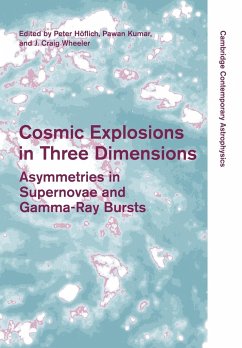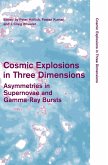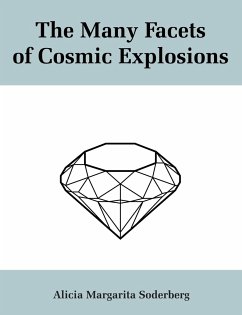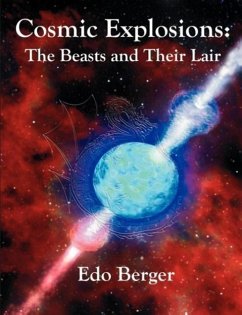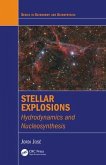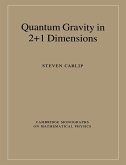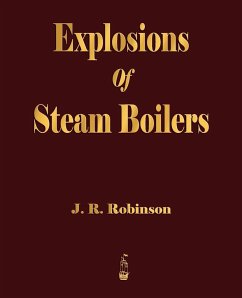Cosmic Explosions in Three Dimensions
Asymmetries in Supernovae and Gamma-Ray Bursts
Herausgeber: H. Flich, Peter; Wheeler, J. Craig; Kumar, Pawan
Cosmic Explosions in Three Dimensions
Asymmetries in Supernovae and Gamma-Ray Bursts
Herausgeber: H. Flich, Peter; Wheeler, J. Craig; Kumar, Pawan
- Broschiertes Buch
- Merkliste
- Auf die Merkliste
- Bewerten Bewerten
- Teilen
- Produkt teilen
- Produkterinnerung
- Produkterinnerung
Originally published in 2004, this volume marked the transition to a fresh paradigm in the study of stellar explosions.
Andere Kunden interessierten sich auch für
![Cosmic Explosions in Three Dimensions Cosmic Explosions in Three Dimensions]() Peter Höflich / Pawan Kumar / J. Craig Wheeler (eds.)Cosmic Explosions in Three Dimensions237,99 €
Peter Höflich / Pawan Kumar / J. Craig Wheeler (eds.)Cosmic Explosions in Three Dimensions237,99 €![The Many Facets of Cosmic Explosions The Many Facets of Cosmic Explosions]() Alicia SoderbergThe Many Facets of Cosmic Explosions31,99 €
Alicia SoderbergThe Many Facets of Cosmic Explosions31,99 €![Cosmic Explosions Cosmic Explosions]() Edo BergerCosmic Explosions25,99 €
Edo BergerCosmic Explosions25,99 €![Stellar Explosions Stellar Explosions]() Jordi JoseStellar Explosions258,99 €
Jordi JoseStellar Explosions258,99 €![The Three-Body Problem The Three-Body Problem]() Mauri ValtonenThe Three-Body Problem111,99 €
Mauri ValtonenThe Three-Body Problem111,99 €![Quantum Gravity in 2+1 Dimensions Quantum Gravity in 2+1 Dimensions]() Steven CarlipQuantum Gravity in 2+1 Dimensions77,99 €
Steven CarlipQuantum Gravity in 2+1 Dimensions77,99 €![Explosions Of Steam Boilers Explosions Of Steam Boilers]() J. R. RobinsonExplosions Of Steam Boilers11,99 €
J. R. RobinsonExplosions Of Steam Boilers11,99 €-
-
-
Originally published in 2004, this volume marked the transition to a fresh paradigm in the study of stellar explosions.
Hinweis: Dieser Artikel kann nur an eine deutsche Lieferadresse ausgeliefert werden.
Hinweis: Dieser Artikel kann nur an eine deutsche Lieferadresse ausgeliefert werden.
Produktdetails
- Produktdetails
- Verlag: Cambridge University Press
- Seitenzahl: 392
- Erscheinungstermin: 26. Mai 2011
- Englisch
- Abmessung: 244mm x 170mm x 21mm
- Gewicht: 675g
- ISBN-13: 9781107403116
- ISBN-10: 1107403111
- Artikelnr.: 33627443
- Herstellerkennzeichnung
- Libri GmbH
- Europaallee 1
- 36244 Bad Hersfeld
- gpsr@libri.de
- Verlag: Cambridge University Press
- Seitenzahl: 392
- Erscheinungstermin: 26. Mai 2011
- Englisch
- Abmessung: 244mm x 170mm x 21mm
- Gewicht: 675g
- ISBN-13: 9781107403116
- ISBN-10: 1107403111
- Artikelnr.: 33627443
- Herstellerkennzeichnung
- Libri GmbH
- Europaallee 1
- 36244 Bad Hersfeld
- gpsr@libri.de
Introduction: 3-D Explosions: a meditation on rotation (and magnetic
fields) J. C. Wheeler; Part I. Supernovae: Observations Today: 1. Supernova
explosions: lessons from spectropolarimetry L. Wang; 2. Spectropolarimetric
observations of Supernovae A. Filippenko and D. C. Leonard; 3. Observed and
physical properties of type II plateau supernovae M. Hamuy; 4. SN1997B and
the different types of Type Ic Supernovae A. Clocchiatti, B. Leibundgut, J.
Spyromilio, S. Benetti, E. Cappelaro, M. Turatto and M. Phillips; 5.
Near-infrared spectroscopy of stripped-envelope Supernovae C. L. Gerardy,
R. A. Fesen, G. H. Marion, P. Hoeflich and J. C. Wheeler; 6. Morphology of
Supernovae remnants R. Fesen; 7. The evolution of Supernova remnants in the
winds of massive stars V. Dwarkadas; 8. Types for the galactic Supernovae
B. E. Schaefer; Part II. Theory of Thermonuclear Supernovae: 9. Semi-steady
burning evolutionary sequences for CAL 83 and CAL 87: supersoft X-ray
binaries are Supernovae Ia progenitors S. Starrfield, F. X. Timmes, W. R.
Hix, E. M. Sion, W. M. Sparks and S. Dwyer; 10. Type Ia Supernovae
progenitors: effects of the spin-up of the white dwarfs S.-C. Yoon and N.
Langer; 11. Terrestrial combustion: feedback to the stars E. S. Oran; 12.
Non-spherical delayed detonations E. Livne; 13. Numerical simulations of
Type Ia Supernovae: deflagrations and detonations V. N. Gamezo, A. M.
Khokhlov and E. S. Oran; 14. Type Ia Supernovae: spectroscopic surprises D.
Branch; 15. Aspherity effects in Supernovae P. Hoeflich, C. Gerardy and R.
Quimby; 16. Broad light curve SneIa: asphericity or something else? A.
Howell and P. Nugent; 17. Synthetic spectrum methods for 3-D SN models R.
Thomas; 18. A hole in Ia' spectroscopic and polarimetric signatures of SN
Ia asymmetry due to a companion star D. Kasen; 19. Hunting for the
signatures of 3-D explosions with 1-D synthetic spectra E. Lentz, E. Baron
and P. H. Hauschildt; 20. On the variation of the peak luminosity of Type
Ia J. W. Truran, E. X. Timmes and E. F. Brown; Part III. Theory of Core
Collapse Supernovae: 21. Rotation of core collapse progenitors: single and
binary stars N. Langer; 22. Large scale convection and the convective
Supernova mechanism S. Colgate and M. E. Herant; 23. Topics in
core-collapse Supernova A. Burrows, C. D. Ott and C. Meakin; 24. MHD
Supernova jets: the missing link D. Meier and M. Nakamura; 25. Effects of
super strong magnetic fields in core collapse Supernovae I. S. Akiyama; 26.
Non radial instability of stalled accretion shocks advective-acoustic cycle
T. Foglizzo and P. Galletti; 27. Asymmetry effects in Hypernovae K. Maeda,
K. Nomoto, J. Deng and P.A. Mazzali; 28. Turbulent MHD jet collimation and
thermal driving P. T. Williams; Part IV. Magnetars, N-Stars, Pulsars: 29.
Supernova remnants and pulsar wind nebulae R. Chevalier; 30. X-Ray
signatures of Supernovae D. Swartz; 31. Asymmetric Supernovae and Neutron
Star Kicks D. Lai and D. Q. Lamb; 32. Triggers of magnetar outbursts R.
Duncan; 33. Turbulent MHD Jet Collimation and Thermal Driving P. Williams;
34. The interplay between nuclear electron capture and fluid dynamics in
core collapse Supernovae W. R. Hix, O. E. B. Messer and A. Mezzacappa; Part
V. Gamma-Ray Bursts: 35. GRB 021004 and Gamma-ray burst distances B. E.
Schaefer; 36. Gamma-ray bursts as a laboratory for the study of Type Ic
Supernovae D. Q. Lamb, T. Q. Donaghy and C. Graziani; 37. The diversity of
cosmic explosions: Gamma-ray bursts and Type Ib/c Supernovae E. Berger; 38.
A GRB simulation using 3D relativistic hydrodynamics J. Cannizo, N. Gehrels
and E. T. Vishniac; 39. The first direct link in the Supernova/GRB
connection: GRB 030329 and SN 2003dh T. Matheson; Part VI. Summary: 40.
Three-dimensional explosions C. Wheeler.
fields) J. C. Wheeler; Part I. Supernovae: Observations Today: 1. Supernova
explosions: lessons from spectropolarimetry L. Wang; 2. Spectropolarimetric
observations of Supernovae A. Filippenko and D. C. Leonard; 3. Observed and
physical properties of type II plateau supernovae M. Hamuy; 4. SN1997B and
the different types of Type Ic Supernovae A. Clocchiatti, B. Leibundgut, J.
Spyromilio, S. Benetti, E. Cappelaro, M. Turatto and M. Phillips; 5.
Near-infrared spectroscopy of stripped-envelope Supernovae C. L. Gerardy,
R. A. Fesen, G. H. Marion, P. Hoeflich and J. C. Wheeler; 6. Morphology of
Supernovae remnants R. Fesen; 7. The evolution of Supernova remnants in the
winds of massive stars V. Dwarkadas; 8. Types for the galactic Supernovae
B. E. Schaefer; Part II. Theory of Thermonuclear Supernovae: 9. Semi-steady
burning evolutionary sequences for CAL 83 and CAL 87: supersoft X-ray
binaries are Supernovae Ia progenitors S. Starrfield, F. X. Timmes, W. R.
Hix, E. M. Sion, W. M. Sparks and S. Dwyer; 10. Type Ia Supernovae
progenitors: effects of the spin-up of the white dwarfs S.-C. Yoon and N.
Langer; 11. Terrestrial combustion: feedback to the stars E. S. Oran; 12.
Non-spherical delayed detonations E. Livne; 13. Numerical simulations of
Type Ia Supernovae: deflagrations and detonations V. N. Gamezo, A. M.
Khokhlov and E. S. Oran; 14. Type Ia Supernovae: spectroscopic surprises D.
Branch; 15. Aspherity effects in Supernovae P. Hoeflich, C. Gerardy and R.
Quimby; 16. Broad light curve SneIa: asphericity or something else? A.
Howell and P. Nugent; 17. Synthetic spectrum methods for 3-D SN models R.
Thomas; 18. A hole in Ia' spectroscopic and polarimetric signatures of SN
Ia asymmetry due to a companion star D. Kasen; 19. Hunting for the
signatures of 3-D explosions with 1-D synthetic spectra E. Lentz, E. Baron
and P. H. Hauschildt; 20. On the variation of the peak luminosity of Type
Ia J. W. Truran, E. X. Timmes and E. F. Brown; Part III. Theory of Core
Collapse Supernovae: 21. Rotation of core collapse progenitors: single and
binary stars N. Langer; 22. Large scale convection and the convective
Supernova mechanism S. Colgate and M. E. Herant; 23. Topics in
core-collapse Supernova A. Burrows, C. D. Ott and C. Meakin; 24. MHD
Supernova jets: the missing link D. Meier and M. Nakamura; 25. Effects of
super strong magnetic fields in core collapse Supernovae I. S. Akiyama; 26.
Non radial instability of stalled accretion shocks advective-acoustic cycle
T. Foglizzo and P. Galletti; 27. Asymmetry effects in Hypernovae K. Maeda,
K. Nomoto, J. Deng and P.A. Mazzali; 28. Turbulent MHD jet collimation and
thermal driving P. T. Williams; Part IV. Magnetars, N-Stars, Pulsars: 29.
Supernova remnants and pulsar wind nebulae R. Chevalier; 30. X-Ray
signatures of Supernovae D. Swartz; 31. Asymmetric Supernovae and Neutron
Star Kicks D. Lai and D. Q. Lamb; 32. Triggers of magnetar outbursts R.
Duncan; 33. Turbulent MHD Jet Collimation and Thermal Driving P. Williams;
34. The interplay between nuclear electron capture and fluid dynamics in
core collapse Supernovae W. R. Hix, O. E. B. Messer and A. Mezzacappa; Part
V. Gamma-Ray Bursts: 35. GRB 021004 and Gamma-ray burst distances B. E.
Schaefer; 36. Gamma-ray bursts as a laboratory for the study of Type Ic
Supernovae D. Q. Lamb, T. Q. Donaghy and C. Graziani; 37. The diversity of
cosmic explosions: Gamma-ray bursts and Type Ib/c Supernovae E. Berger; 38.
A GRB simulation using 3D relativistic hydrodynamics J. Cannizo, N. Gehrels
and E. T. Vishniac; 39. The first direct link in the Supernova/GRB
connection: GRB 030329 and SN 2003dh T. Matheson; Part VI. Summary: 40.
Three-dimensional explosions C. Wheeler.
Introduction: 3-D Explosions: a meditation on rotation (and magnetic
fields) J. C. Wheeler; Part I. Supernovae: Observations Today: 1. Supernova
explosions: lessons from spectropolarimetry L. Wang; 2. Spectropolarimetric
observations of Supernovae A. Filippenko and D. C. Leonard; 3. Observed and
physical properties of type II plateau supernovae M. Hamuy; 4. SN1997B and
the different types of Type Ic Supernovae A. Clocchiatti, B. Leibundgut, J.
Spyromilio, S. Benetti, E. Cappelaro, M. Turatto and M. Phillips; 5.
Near-infrared spectroscopy of stripped-envelope Supernovae C. L. Gerardy,
R. A. Fesen, G. H. Marion, P. Hoeflich and J. C. Wheeler; 6. Morphology of
Supernovae remnants R. Fesen; 7. The evolution of Supernova remnants in the
winds of massive stars V. Dwarkadas; 8. Types for the galactic Supernovae
B. E. Schaefer; Part II. Theory of Thermonuclear Supernovae: 9. Semi-steady
burning evolutionary sequences for CAL 83 and CAL 87: supersoft X-ray
binaries are Supernovae Ia progenitors S. Starrfield, F. X. Timmes, W. R.
Hix, E. M. Sion, W. M. Sparks and S. Dwyer; 10. Type Ia Supernovae
progenitors: effects of the spin-up of the white dwarfs S.-C. Yoon and N.
Langer; 11. Terrestrial combustion: feedback to the stars E. S. Oran; 12.
Non-spherical delayed detonations E. Livne; 13. Numerical simulations of
Type Ia Supernovae: deflagrations and detonations V. N. Gamezo, A. M.
Khokhlov and E. S. Oran; 14. Type Ia Supernovae: spectroscopic surprises D.
Branch; 15. Aspherity effects in Supernovae P. Hoeflich, C. Gerardy and R.
Quimby; 16. Broad light curve SneIa: asphericity or something else? A.
Howell and P. Nugent; 17. Synthetic spectrum methods for 3-D SN models R.
Thomas; 18. A hole in Ia' spectroscopic and polarimetric signatures of SN
Ia asymmetry due to a companion star D. Kasen; 19. Hunting for the
signatures of 3-D explosions with 1-D synthetic spectra E. Lentz, E. Baron
and P. H. Hauschildt; 20. On the variation of the peak luminosity of Type
Ia J. W. Truran, E. X. Timmes and E. F. Brown; Part III. Theory of Core
Collapse Supernovae: 21. Rotation of core collapse progenitors: single and
binary stars N. Langer; 22. Large scale convection and the convective
Supernova mechanism S. Colgate and M. E. Herant; 23. Topics in
core-collapse Supernova A. Burrows, C. D. Ott and C. Meakin; 24. MHD
Supernova jets: the missing link D. Meier and M. Nakamura; 25. Effects of
super strong magnetic fields in core collapse Supernovae I. S. Akiyama; 26.
Non radial instability of stalled accretion shocks advective-acoustic cycle
T. Foglizzo and P. Galletti; 27. Asymmetry effects in Hypernovae K. Maeda,
K. Nomoto, J. Deng and P.A. Mazzali; 28. Turbulent MHD jet collimation and
thermal driving P. T. Williams; Part IV. Magnetars, N-Stars, Pulsars: 29.
Supernova remnants and pulsar wind nebulae R. Chevalier; 30. X-Ray
signatures of Supernovae D. Swartz; 31. Asymmetric Supernovae and Neutron
Star Kicks D. Lai and D. Q. Lamb; 32. Triggers of magnetar outbursts R.
Duncan; 33. Turbulent MHD Jet Collimation and Thermal Driving P. Williams;
34. The interplay between nuclear electron capture and fluid dynamics in
core collapse Supernovae W. R. Hix, O. E. B. Messer and A. Mezzacappa; Part
V. Gamma-Ray Bursts: 35. GRB 021004 and Gamma-ray burst distances B. E.
Schaefer; 36. Gamma-ray bursts as a laboratory for the study of Type Ic
Supernovae D. Q. Lamb, T. Q. Donaghy and C. Graziani; 37. The diversity of
cosmic explosions: Gamma-ray bursts and Type Ib/c Supernovae E. Berger; 38.
A GRB simulation using 3D relativistic hydrodynamics J. Cannizo, N. Gehrels
and E. T. Vishniac; 39. The first direct link in the Supernova/GRB
connection: GRB 030329 and SN 2003dh T. Matheson; Part VI. Summary: 40.
Three-dimensional explosions C. Wheeler.
fields) J. C. Wheeler; Part I. Supernovae: Observations Today: 1. Supernova
explosions: lessons from spectropolarimetry L. Wang; 2. Spectropolarimetric
observations of Supernovae A. Filippenko and D. C. Leonard; 3. Observed and
physical properties of type II plateau supernovae M. Hamuy; 4. SN1997B and
the different types of Type Ic Supernovae A. Clocchiatti, B. Leibundgut, J.
Spyromilio, S. Benetti, E. Cappelaro, M. Turatto and M. Phillips; 5.
Near-infrared spectroscopy of stripped-envelope Supernovae C. L. Gerardy,
R. A. Fesen, G. H. Marion, P. Hoeflich and J. C. Wheeler; 6. Morphology of
Supernovae remnants R. Fesen; 7. The evolution of Supernova remnants in the
winds of massive stars V. Dwarkadas; 8. Types for the galactic Supernovae
B. E. Schaefer; Part II. Theory of Thermonuclear Supernovae: 9. Semi-steady
burning evolutionary sequences for CAL 83 and CAL 87: supersoft X-ray
binaries are Supernovae Ia progenitors S. Starrfield, F. X. Timmes, W. R.
Hix, E. M. Sion, W. M. Sparks and S. Dwyer; 10. Type Ia Supernovae
progenitors: effects of the spin-up of the white dwarfs S.-C. Yoon and N.
Langer; 11. Terrestrial combustion: feedback to the stars E. S. Oran; 12.
Non-spherical delayed detonations E. Livne; 13. Numerical simulations of
Type Ia Supernovae: deflagrations and detonations V. N. Gamezo, A. M.
Khokhlov and E. S. Oran; 14. Type Ia Supernovae: spectroscopic surprises D.
Branch; 15. Aspherity effects in Supernovae P. Hoeflich, C. Gerardy and R.
Quimby; 16. Broad light curve SneIa: asphericity or something else? A.
Howell and P. Nugent; 17. Synthetic spectrum methods for 3-D SN models R.
Thomas; 18. A hole in Ia' spectroscopic and polarimetric signatures of SN
Ia asymmetry due to a companion star D. Kasen; 19. Hunting for the
signatures of 3-D explosions with 1-D synthetic spectra E. Lentz, E. Baron
and P. H. Hauschildt; 20. On the variation of the peak luminosity of Type
Ia J. W. Truran, E. X. Timmes and E. F. Brown; Part III. Theory of Core
Collapse Supernovae: 21. Rotation of core collapse progenitors: single and
binary stars N. Langer; 22. Large scale convection and the convective
Supernova mechanism S. Colgate and M. E. Herant; 23. Topics in
core-collapse Supernova A. Burrows, C. D. Ott and C. Meakin; 24. MHD
Supernova jets: the missing link D. Meier and M. Nakamura; 25. Effects of
super strong magnetic fields in core collapse Supernovae I. S. Akiyama; 26.
Non radial instability of stalled accretion shocks advective-acoustic cycle
T. Foglizzo and P. Galletti; 27. Asymmetry effects in Hypernovae K. Maeda,
K. Nomoto, J. Deng and P.A. Mazzali; 28. Turbulent MHD jet collimation and
thermal driving P. T. Williams; Part IV. Magnetars, N-Stars, Pulsars: 29.
Supernova remnants and pulsar wind nebulae R. Chevalier; 30. X-Ray
signatures of Supernovae D. Swartz; 31. Asymmetric Supernovae and Neutron
Star Kicks D. Lai and D. Q. Lamb; 32. Triggers of magnetar outbursts R.
Duncan; 33. Turbulent MHD Jet Collimation and Thermal Driving P. Williams;
34. The interplay between nuclear electron capture and fluid dynamics in
core collapse Supernovae W. R. Hix, O. E. B. Messer and A. Mezzacappa; Part
V. Gamma-Ray Bursts: 35. GRB 021004 and Gamma-ray burst distances B. E.
Schaefer; 36. Gamma-ray bursts as a laboratory for the study of Type Ic
Supernovae D. Q. Lamb, T. Q. Donaghy and C. Graziani; 37. The diversity of
cosmic explosions: Gamma-ray bursts and Type Ib/c Supernovae E. Berger; 38.
A GRB simulation using 3D relativistic hydrodynamics J. Cannizo, N. Gehrels
and E. T. Vishniac; 39. The first direct link in the Supernova/GRB
connection: GRB 030329 and SN 2003dh T. Matheson; Part VI. Summary: 40.
Three-dimensional explosions C. Wheeler.

